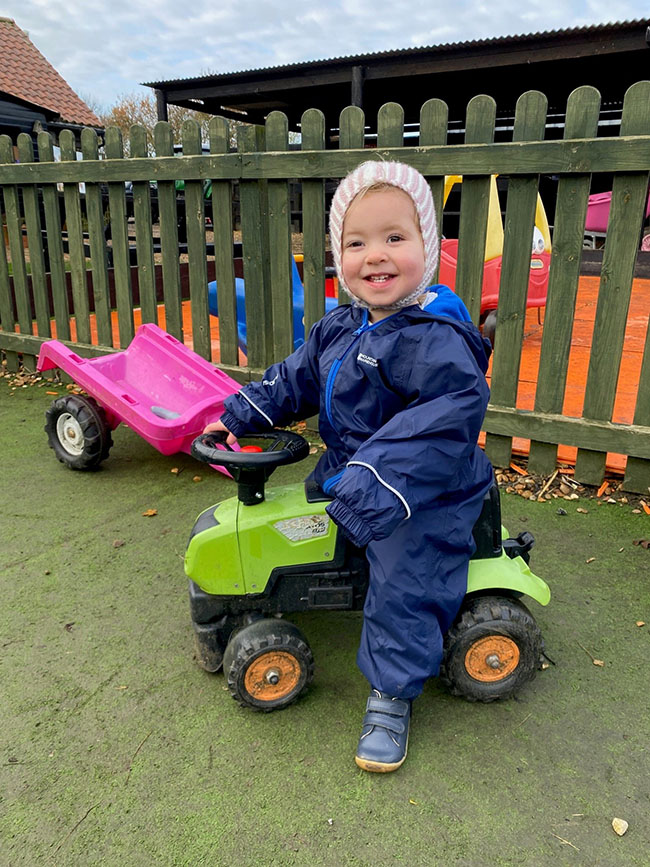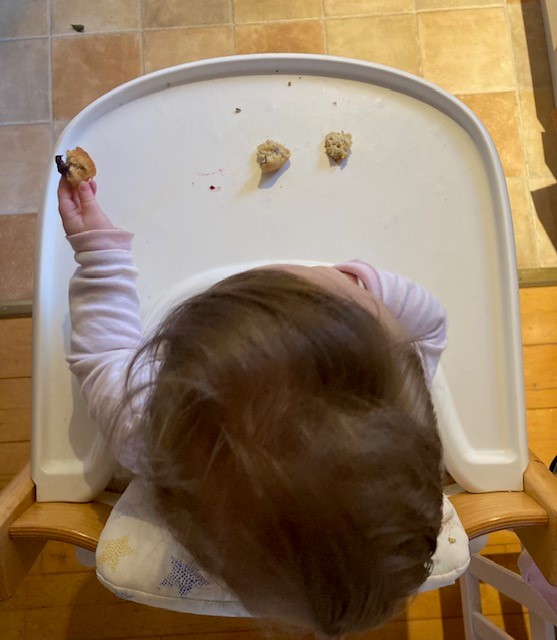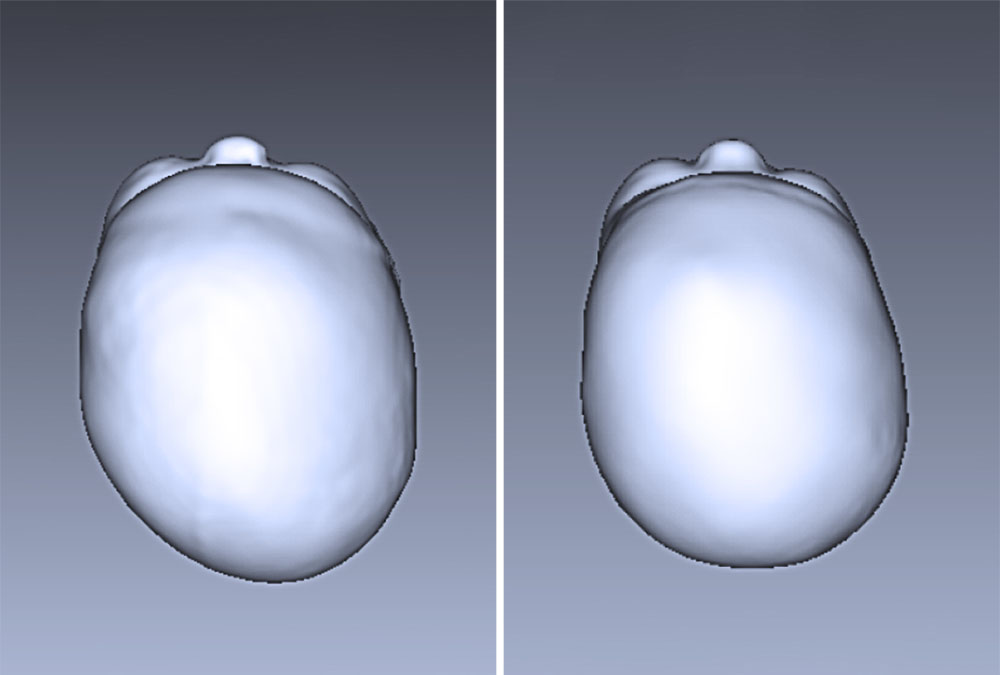
18 January 2023
Amelia’s asymmetrical head shape was corrected even though her treatment did not start until she was over a year old.
Amelia was first assessed by LOC on 24 March, just after her first birthday. She visually presented with quite severe plagiocephaly. This was confirmed when measurements of her head shape were taken. Amelia’s cranial vault asymmetry was 18mm; this measurement compares the right and left diagonals at 30 degrees from the centre of the head (front to back), and subtracting one from the other gives the asymmetry value. Less than 6mm is regarded as being within the normal range of head shape, anything over 12mm is deemed to be very severe. The diagnosis confirmed Victoria’s (Amelia’s mother) concerns.
“We knew Amelia’s head shape was not ideal from very early on. We think it was caused by a restriction in Amelia’s neck movement from birth which resulted in her favouring a side while sleeping. We went to see a Cranial Osteopath and a Physio for Amelia’s neck movement from week 4 and discussed Amelia’s head shape, both privately and on the NHS, all of whom said, “you could do something, but it will work its way out”. We took the advice that we were given, that all changed when we met up with Amelia’s wonderful childminder when Amelia was 11 months old, she really pushed us to look into it further. She happened to have twins in her care that were being treated for Plagiocephaly and had seen the huge improvements that successful treatment could bring.
We are so lucky to have the NHS and one totally understands why they cannot offer everything! The treatment for Amelia was purely for cosmetic reasons so I understand it cannot be a priority. That said, as it is not a treatment that the NHS offers, all the wonderful staff don’t appear to recommend the private treatment route at all. If they had done so, we could have started Amelia’s treatment much earlier with potentially even better results.

Amelia's head shape before treatment

Amelia's head scan before treatment with an asymmetry value of 18mm, and after, at 9mm.
LOC had been mentioned on a couple of occasions and so it was our first port of call. We really liked the fact we could send in photos to see if there was a chance of treatment before doing anything else! We heard back really quickly that they felt it was something they could help with, and we booked a free consultation to talk through what was involved and to understand the cost and likelihood of success.
We met with Connor, one of LOC’s senior orthotists, who was fantastic from the start, he really did underpromise and over deliver!! He was very careful to manage our expectations in terms of treatment length and outcome which we were very grateful for. He was brilliant with Amelia too which given it was a 3-hour round trip for each appointment made the whole thing much easier! Connor also gave us his mobile number so we could check in if there was anything that worried us.
Amelia never minded wearing her helmet (the LOCband Lite) and took the whole thing in her stride, it actually took us a little longer to get used to it but really it has been no problem at all. Our main advice for anyone who has a niggling feeling they should be doing something is to send photos into LOC and have the conversation, there is no pressure to proceed and if you do decide that treatment is a good route, the care is second to none.”
Amelia’s final scan was on 25 November last year. Her asymmetry had halved to 9mm. As she was now 19 months old it was agreed that further improvements to her head shape were unlikely. While the optimum age for starting cranial remoulding therapy is 4-5 months successful treatment is perfectly possible up to about the age of 16 months.
If you are concerned about your baby’s head shape, do as Amelia’s mum has suggested, fill out the free photo diagnosis form.
Worried about your baby’s head shape? Find out more about positional plagiocephaly or to book a free consultation with an orthotist, contact LOC.
This is very much dependent on how fast your baby is growing. The faster the growth, the more frequently your baby will be seen so that the helmet can be adjusted. In general, reviews will happen at two to four-week intervals.
The price of treatment covers:
Yes - All babies that have completed their course of treatment with us have achieved a measurable improvement in head shape. However, you don’t have to take our word for it.
Recent independent research conducted by a University Hospital in Germany has endorsed the treatment for babies with moderate or severe plagiocephaly.
A larger, retrospective study has just been published that found complete correction was achieved in 94.4% of babies treated with helmet therapy.
The results were conclusive: repositioning achieved acceptable correction in 77.1% of cases, but 15.8% were moved onto helmet therapy because re-positioning was not working. Meanwhile, 94.4% of the infants who started in the helmet-treated group achieved full correction, as did 96.1% of those who were transferred from the repositioning group into the helmet-treated group.
Further information can be found on our Plagiocephaly Research page.
If your baby has a temperature or a fever due to illness you must remove the band. The band can be put back on once the temperature has returned to normal.
The optimum age for treatment is between four and seven months.
This is because the skull is most malleable at this age and improvements to head shape tend to take less time and are more dramatic. That is not to say that helmet therapy should be ruled out if the baby is older than seven months. Routinely, babies up to the age of 16 months can be treated very successfully.
The cut off age is around 18 months when the fontanelles (soft spots on the head) are no longer malleable. As babies grow and develop at different rates, it is always worth checking if you are not sure. There have been cases where a baby’s fontanelles have not fused yet by the age of 18 months, who have achieved successful, but less-marked results with cranial remoulding therapy.
Torticollis is a condition in which a tight or shortened muscle in one side of the neck causes the head to tilt or turn to one side, resulting in the infant resting its head in the same position. In 2013, we analysed the data from all first appointments in our Kingston clinic and found that 20% of the babies examined had some kind of neck condition that was causing head immobility.
The clinics and clinicians that provide this treatment in the UK will have received similar training and experience. However, we are the only clinic that manufactures its own helmet and our clinicians are closely involved with the process for each individual helmet that we produce.
In addition, we do not restrict review appointments to a set number, we are extremely flexible and respond to individual parents' needs so that the best outcome can be achieved for each baby.
The LOCband is non-invasive and works by applying gentle, constant pressure over the areas of the baby’s skull that are most prominent while allowing unrestricted growth over the flattened areas. The band consists of a soft foam layer inside a thermoplastic shell. As the baby grows, the band will be adjusted frequently to gently guide the skull into a more symmetrical shape.